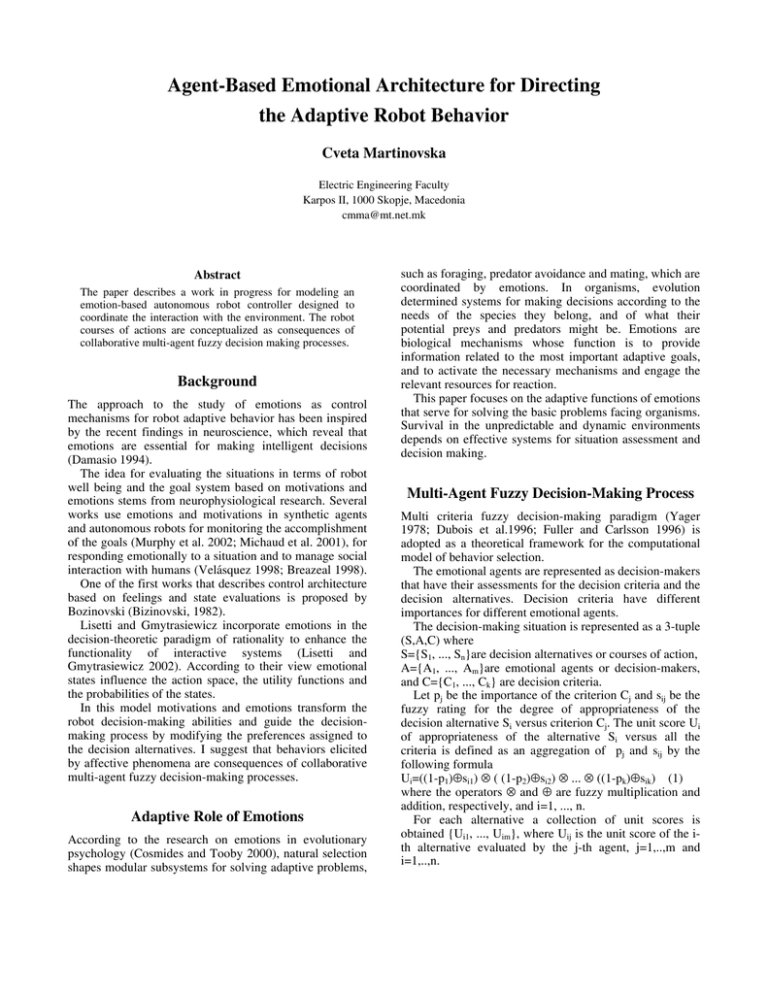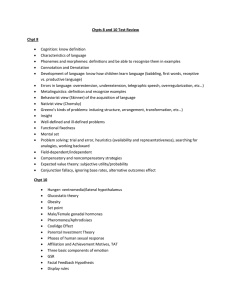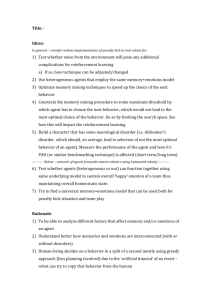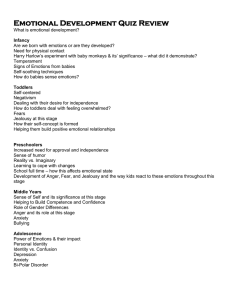Agent-Based Emotional Architecture for Directing the Adaptive Robot Behavior Cveta Martinovska
advertisement

Agent-Based Emotional Architecture for Directing
the Adaptive Robot Behavior
Cveta Martinovska
Electric Engineering Faculty
Karpos II, 1000 Skopje, Macedonia
cmma@mt.net.mk
Abstract
The paper describes a work in progress for modeling an
emotion-based autonomous robot controller designed to
coordinate the interaction with the environment. The robot
courses of actions are conceptualized as consequences of
collaborative multi-agent fuzzy decision making processes.
Background
The approach to the study of emotions as control
mechanisms for robot adaptive behavior has been inspired
by the recent findings in neuroscience, which reveal that
emotions are essential for making intelligent decisions
(Damasio 1994).
The idea for evaluating the situations in terms of robot
well being and the goal system based on motivations and
emotions stems from neurophysiological research. Several
works use emotions and motivations in synthetic agents
and autonomous robots for monitoring the accomplishment
of the goals (Murphy et al. 2002; Michaud et al. 2001), for
responding emotionally to a situation and to manage social
interaction with humans (Velásquez 1998; Breazeal 1998).
One of the first works that describes control architecture
based on feelings and state evaluations is proposed by
Bozinovski (Bizinovski, 1982).
Lisetti and Gmytrasiewicz incorporate emotions in the
decision-theoretic paradigm of rationality to enhance the
functionality of interactive systems (Lisetti and
Gmytrasiewicz 2002). According to their view emotional
states influence the action space, the utility functions and
the probabilities of the states.
In this model motivations and emotions transform the
robot decision-making abilities and guide the decisionmaking process by modifying the preferences assigned to
the decision alternatives. I suggest that behaviors elicited
by affective phenomena are consequences of collaborative
multi-agent fuzzy decision-making processes.
Adaptive Role of Emotions
According to the research on emotions in evolutionary
psychology (Cosmides and Tooby 2000), natural selection
shapes modular subsystems for solving adaptive problems,
such as foraging, predator avoidance and mating, which are
coordinated by emotions. In organisms, evolution
determined systems for making decisions according to the
needs of the species they belong, and of what their
potential preys and predators might be. Emotions are
biological mechanisms whose function is to provide
information related to the most important adaptive goals,
and to activate the necessary mechanisms and engage the
relevant resources for reaction.
This paper focuses on the adaptive functions of emotions
that serve for solving the basic problems facing organisms.
Survival in the unpredictable and dynamic environments
depends on effective systems for situation assessment and
decision making.
Multi-Agent Fuzzy Decision-Making Process
Multi criteria fuzzy decision-making paradigm (Yager
1978; Dubois et al.1996; Fuller and Carlsson 1996) is
adopted as a theoretical framework for the computational
model of behavior selection.
The emotional agents are represented as decision-makers
that have their assessments for the decision criteria and the
decision alternatives. Decision criteria have different
importances for different emotional agents.
The decision-making situation is represented as a 3-tuple
(S,A,C) where
S={S1, ..., Sn}are decision alternatives or courses of action,
A={A1, ..., Am}are emotional agents or decision-makers,
and C={C1, ..., Ck} are decision criteria.
Let pj be the importance of the criterion Cj and sij be the
fuzzy rating for the degree of appropriateness of the
decision alternative Si versus criterion Cj. The unit score Ui
of appropriateness of the alternative Si versus all the
criteria is defined as an aggregation of pj and sij by the
following formula
Ui=((1-p1)⊕si1) ⊗ ( (1-p2)⊕si2) ⊗ ... ⊗ ((1-pk)⊕sik) (1)
where the operators ⊗ and ⊕ are fuzzy multiplication and
addition, respectively, and i=1, ..., n.
For each alternative a collection of unit scores is
obtained {Ui1, ..., Uim}, where Uij is the unit score of the ith alternative evaluated by the j-th agent, j=1,..,m and
i=1,..,n.
The next step of the procedure is to combine the agent's
evaluations of the alternatives in order to select an optimal
action. The basic idea of the mechanism for selecting the
optimal alternative is that each agent tries to maximize its
own interest, but its proposal is evaluated by other agents
and has to be accepted by all of them.
Evaluation of the Decision Criteria
For illustrative purposes I present an example where
internal drives hunger, pain and tiredness are used as
decision criteria and four basic emotions act like decisionmakers. Following term set of the linguistic variable
importance is used for assessment of the decision criteria
T(importance)={VeryHigh,High,Neutral,Low,VeryLow}.
criterion
hunger
pain
tiredness
joy
VL
N
N
sadness
VH
N
N
fear
N
VH
H
anger
N
H
VH
Table 1. Evaluation of the decision criteria
agent
The importances assigned to the decision criteria in
Table 1 show that the energy level (hunger) is more
indicative for the emotions joy and sadness than bumping
into obstacles (pain) and progress in the accomplishment of
the goal (tiredness). Obstacles or enemies on the way to the
target will cause the delay in fulfillment of the goals,
which is monitored by emotions fear and anger.
In this approach emotional agents act as supervisors of
the robot goals, which is similar to the works of Murphy
and Michaud (Murphy et al. 2002; Michaud et al. 2001).
Internal drives and external stimuli are used as activation
mechanisms for the emotions.
Conceptual Configuration of the Controller
The control architecture coordinates the behaviors
according to the robot's goals, needs and estimated external
conditions. The basic adaptive goals of the robot, in this
approach, are related to the "universal problems of
adaptation", as described by Plutchik (Plutchik 1980). The
universal problems of adaptation are hierarchy (anger and
fear), territoriality (exploration and surprise), identity
(acceptance and rejection) and temporality (joy and
sadness).
Emotional agents joy and sadness are responsible for the
maintenance of the robot's appropriate energy level.
Exploration and surprise monitor the process of exploring
the environment in order to reach the targets. Anger and
fear are related to the progress of accomplishment of the
goals. They are used to coordinate behaviors for avoiding
or removing obstacles and relations between preys and
predators. Acceptance and rejection refer to the group
membership. They can be used to include the signals from
the external robots about the environment or potential
threads in the process of evaluating the situations.
The module for perceiving the external environment
provides the sensory information obtained through
different modalities. It assigns fuzzy desirability measures
to the alternative courses of actions.
Action-selection mechanism enables execution of the
behavior that is consistent with the current set of
environmental stimuli and with the internal states. When
the robot executes the action that fulfils a certain need the
intensity of the respective drive is modified and another
behavior becomes more appropriate. The robot is
considered to have a number of behavior systems each
organized to address a specific biological function:
investigative, eliminative, ingestive, destructive, etc.
This paper gives a theoretical framework for
investigating the effects of affective components on the
robot-environment interactions using the techniques of
fuzzy decision-making theory.
References
Bozinovski, S. 1982. A Self-Learning System Using
Secondary Reinforcement. In Trappl, R. ed. Cybernetics
and Systems Research. North Holland. 397-402
Breazeal, C. 1998. Regulating Human-Robot Interaction
Using Emotions, Drives and Facial Expressions. In
Proceedings of Autonomous Agents 98. Minneapolis, MO.
Cosmides,L.; and Tooby,J. 2000. Evolutionary Psychology
and the Emotions. In Lewis,M.;and Haviland-Jones, J. eds.
Handbook of Emotions. New York: Guilford Press. 91-115
Damasio, A. 1994. Descartes' Error: Emotion, Reason,
and the Human Brain. New York: Putnam.
Dubois, D.; Fargier, H.; and Prade, H. 1996. Possibility
Theory in Constraint Satisfaction Problems: Handling
Priority, Preference and Uncertainty. Appl. Intelligent 6
(4): 287-309.
Fuller, R.; and Carlsson, C. 1996. Fuzzy Multiple Criteria
Decision Making: Recent Developments. Fuzzy Sets and
Systems 78:139-153.
Lisetti, C.; and Gmytrasiewicz, P. 2002. Can a Rational
Agent Afford to be Affectless? A Formal Approach.
Applied Artificial Intelligence 16:1-33.
Michaud, F.; Lachiver, G.; and Le Dihn, C.T. 2001. Architectural Methodology Based on Intentional Configuration
of Behaviors. Computational Intelligence 17 (1):132-156.
Murphy,R.;Lisetti, C.;Tardif,R.;Irish,L.;and Gage,A. 2002.
Emotion-Based Control of Cooperating Heterogeneous
Mobile Robots. IEEE Transactions on Robotics and
Automation 18(5):744-757.
Plutchik,R.1980. Emotion:A Psychoevolutionary Synthesis.
New York: Harper & Row.
Velásquez, J.D. 1998. A Computational Framework for
Emotion-Based Control. In Workshop on Grounding
Emotions in Adaptive Systems, Conference on Simulation
of Adaptive Behavior.
Yager, R.1978. Fuzzy Decision Making Including Unequal
Objectives. Fuzzy Sets and Systems 1:87-95.








